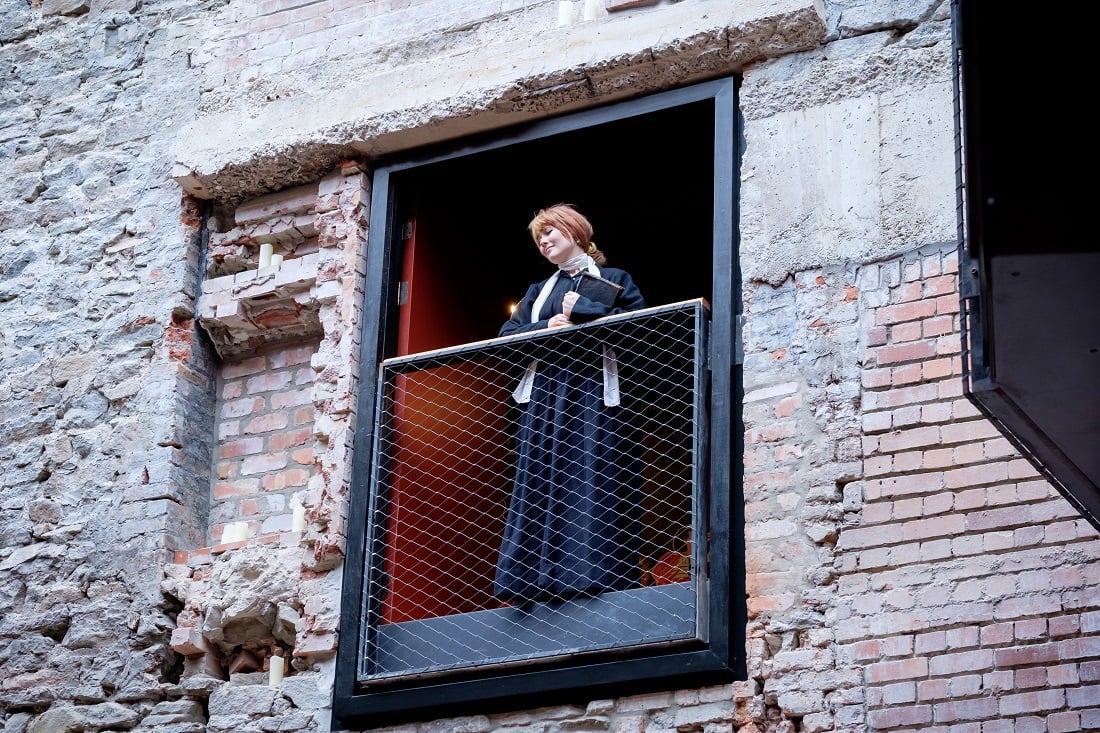
A Limelight Tour at Bristol Old Vic
Photo: Jon Craig
Drawing people in
Bristol Old Vic, England’s oldest theatre, is now also open as a visitor attraction and heritage destination. Emma Stenning explains why – and how – the venue embarked on this new venture.
Last November, we transformed Bristol Old Vic into a heritage attraction in a bid to completely overhaul and safeguard the future of this historical and cultural gem. The heritage project, entitled ‘Protecting and sharing the history of England’s oldest theatre’, was made possible by a £2.4m grant from the Heritage Lottery Fund (HLF).
Operationally, the challenge is how to be both a working organisation and a heritage destination
Securing the funding was hard. As a theatre, we weren’t used to thinking as a heritage organisation, and it took us time to learn how to. HLF was supportive, giving us constructive feedback throughout the three years that it helped us develop our final successful bid.
Through workshops with artists and staff, working alongside some heritage consultants, and with the support of HLF, we have been able to develop an exciting scheme. We have worked hard to develop each of the elements within the project, eventually commissioning local artists to work up the final designs. Most of the installation had to wait until we had finished building our new foyer and it has been fantastic to see these projects finally come to fruition.
A different operation
Operationally, the challenge is how to be both a working organisation and a heritage destination, since we’re looking to provide a visitor experience in a living, breathing theatre. Should you take tours into the auditorium during a technical rehearsal? Can you have people in an interactive exhibition next to the theatre while a show is on? Can people be wandering round the foyer gazing into an augmented reality (AR) app while others are sitting down for lunch?
We always say that we ‘learn by doing’, and that is certainly an ethos we have employed following our reopening. We’re discovering more and more about the logistics behind running a heritage experience and are grateful to those who have visited our soft launch and provided invaluable feedback.
In terms of our strategy as a business, it’s all about our daytime trade. We’re no longer a building that opens 90 minutes before the show. Anyone can now come here from breakfast through to last orders. We hope that, along with delicious food and a wonderful social space, the heritage experience is something that will draw people in, encouraging them to spend more time in our building and explore everything we’ve now got on offer.
It’s also about our mission to protect and share our heritage. No other theatre can tell a story that is 252 years old, and we want to use our history to inspire our artists, staff and audiences. Perhaps most importantly, we hope that the experience will simply connect people more closely to the theatre, enabling them to see their visit in the context of 252 years of theatre-making and watching.
New attractions
The new attraction is comprised of a number of commissioned artworks from local artists, ranging from murals that depict the history of both the theatre and its surrounding neighbourhood, to a digital AR experience that will allow visitors to step back in time to see the building as it was in different eras. There are new exhibition spaces, animated tours and interactive experiences, as well as a film called ‘The House is Open’, developed in partnership with Aardman and Limbic Cinema.
Our exhibition space will rotate twice a year, allowing us to display new items from our archive and link them thematically to our programme. We have also launched a digital archive interface ‘touch table’ where visitors can access the thousands of archival items that have been digitised as part of the project – from the theatre’s original 1778 license to old theatre ticket stubs found under the stage from 1927.
We have an archive, cared for by the University of Bristol’s Theatre Collection, and the city council’s Bristol Archives. While this provides access to those who know they want to explore these stories as a theatre, we’d never before considered how we might look to bring our history alive in the building and more actively share our 252-year heritage with our audiences and visitors.
As well as making a significant contribution to the restoration of the theatre’s historic fabric, the project has helped deliver a wide-ranging programme of heritage activity across the city, and sees the launch of a range of new artworks, exhibits and interactive experiences within the building itself.
This project has taught us to take the time to understand the skills of the heritage sector, while always remembering that at the interface of heritage practice and theatre-making lies a creative opportunity. All our heritage work is about being faithful to our history, and deeply respectful of our archives, while also being led by how these stories and collections inspire artists. The result, I believe, is a magical experience for everyone at Bristol Old Vic.
Emma Stenning is the former Chief Executive of Bristol Old Vic (and now Executive Director of Soulpepper Theatre Company in Toronto).
www.bristololdvic.org.uk
Tw @BristolOldVic
Join the Discussion
You must be logged in to post a comment.